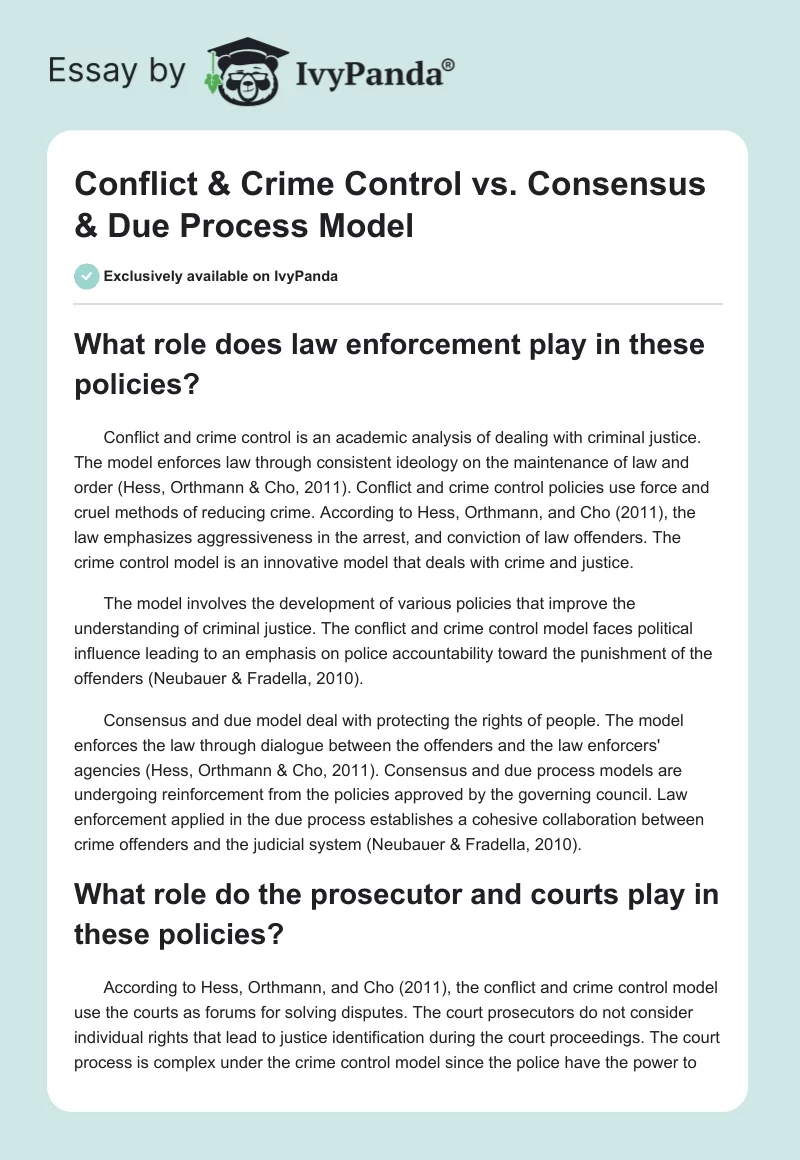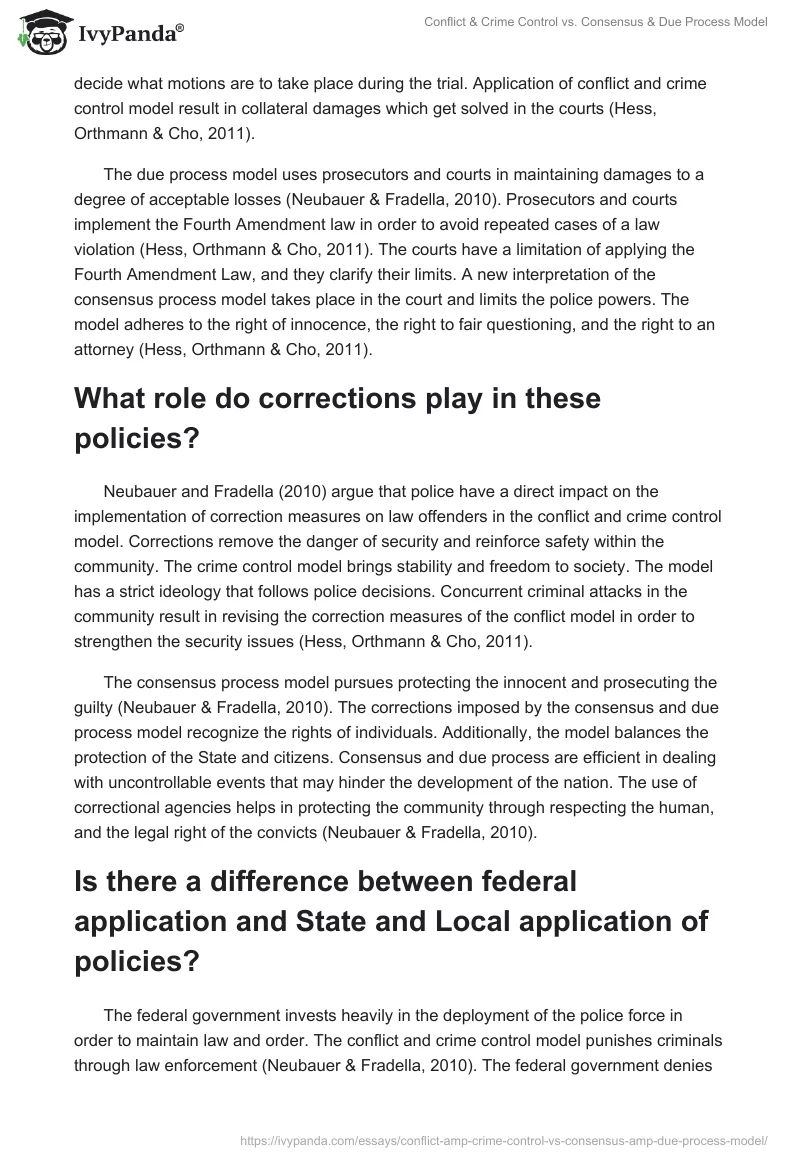What role does law enforcement play in these policies?
Conflict and crime control is an academic analysis of dealing with criminal justice. The model enforces law through consistent ideology on the maintenance of law and order (Hess, Orthmann & Cho, 2011). Conflict and crime control policies use force and cruel methods of reducing crime. According to Hess, Orthmann, and Cho (2011), the law emphasizes aggressiveness in the arrest, and conviction of law offenders. The crime control model is an innovative model that deals with crime and justice.
The model involves the development of various policies that improve the understanding of criminal justice. The conflict and crime control model faces political influence leading to an emphasis on police accountability toward the punishment of the offenders (Neubauer & Fradella, 2010).
Consensus and due model deal with protecting the rights of people. The model enforces the law through dialogue between the offenders and the law enforcers’ agencies (Hess, Orthmann & Cho, 2011). Consensus and due process models are undergoing reinforcement from the policies approved by the governing council. Law enforcement applied in the due process establishes a cohesive collaboration between crime offenders and the judicial system (Neubauer & Fradella, 2010).
What role do the prosecutor and courts play in these policies?
According to Hess, Orthmann, and Cho (2011), the conflict and crime control model use the courts as forums for solving disputes. The court prosecutors do not consider individual rights that lead to justice identification during the court proceedings. The court process is complex under the crime control model since the police have the power to decide what motions are to take place during the trial. Application of conflict and crime control model result in collateral damages which get solved in the courts (Hess, Orthmann & Cho, 2011).
The due process model uses prosecutors and courts in maintaining damages to a degree of acceptable losses (Neubauer & Fradella, 2010). Prosecutors and courts implement the Fourth Amendment law in order to avoid repeated cases of a law violation (Hess, Orthmann & Cho, 2011). The courts have a limitation of applying the Fourth Amendment Law, and they clarify their limits. A new interpretation of the consensus process model takes place in the court and limits the police powers. The model adheres to the right of innocence, the right to fair questioning, and the right to an attorney (Hess, Orthmann & Cho, 2011).
What role do corrections play in these policies?
Neubauer and Fradella (2010) argue that police have a direct impact on the implementation of correction measures on law offenders in the conflict and crime control model. Corrections remove the danger of security and reinforce safety within the community. The crime control model brings stability and freedom to society. The model has a strict ideology that follows police decisions. Concurrent criminal attacks in the community result in revising the correction measures of the conflict model in order to strengthen the security issues (Hess, Orthmann & Cho, 2011).
The consensus process model pursues protecting the innocent and prosecuting the guilty (Neubauer & Fradella, 2010). The corrections imposed by the consensus and due process model recognize the rights of individuals. Additionally, the model balances the protection of the State and citizens. Consensus and due process are efficient in dealing with uncontrollable events that may hinder the development of the nation. The use of correctional agencies helps in protecting the community through respecting the human, and the legal right of the convicts (Neubauer & Fradella, 2010).
Is there a difference between federal application and State and Local application of policies?
The federal government invests heavily in the deployment of the police force in order to maintain law and order. The conflict and crime control model punishes criminals through law enforcement (Neubauer & Fradella, 2010). The federal government denies the perpetrators’ rights in the criminal process. Criminal arrest shows the denial of human rights, and violation of the Fourth Amendment, which mainly takes place in the federal court system. Breaking the law undermines the individual’s freedom under the federal government, which results in the application of the conflict and crime control model.
State and local governments apply the consensus process model in order to offer long-lasting corrective measures (Hess, Orthmann & Cho, 2011). The consensus and due process model do not speed up the judicial process which rhymes with the State government mode of dealing with crime. Hess, Orthmann, and Cho (2011) argue that the due process model balances the attrition research of the case with clearance charges. The model gives confidence to the criminals that they will obtain justice and an appropriate sentence (Hess, Orthmann & Cho, 2011).
What is your opinion of the various policies? Explain in detail
The police and courts are the main bodies in the conflict control model of criminal justice (Hess, Orthmann & Cho, 2011). The policy has a standard method of operation and deals with the criminal process. Constitutional values and individuals’ rights are essential in dealing with crime. Court hearings do not reflect the punishment the perpetrators will face after the final judgment in the conflict and crime control model. The model does not overlap the work of the police, courts, and corrections. In some situations, the crime control model lacks full implementation allowing the guilty escape unpunished.
Consensus and due process models use policies that protect individual rights. The judicial system balances the pleas from the defendants, and the prosecutors in order to avoid bias. The model believes that cruel punishment creates criticism and denies freedom to the law offenders. Consensus and due process models use correctional agencies in order to implement the Fourth Amendment law. Scholars in the due process model view crime as a result of social influence, and not moral decay.
How can we measure the effectiveness of these policies?
Comparing two cities with similar demographics is an efficient way of measuring the effectiveness of the conflict control model and the due process model. The cities that have a high deployment of police apply the crime control model, whereas the cities with a low deployment of police apply the due process model (Hess, Orthmann & Cho, 2011). The consensus and due process model deal with fighting for human rights during the judicial process which gets characterized by the presence of many correctional agencies in the city. Cities that apply the crime control model use police in conducting the prosecution and aim at offering individual liberty.
The funds from the federal government get channeled through the conflict and crime control model. On the other hand, the State government solicits funds from private correctional agencies in order to implement the justice system fully (Hess, Orthmann & Cho, 2011). In addition, the federal government sensitizes private enterprise through the offer of subsidies on involvement in the implementation of the consensus and due process model (Neubauer & Fradella, 2010).
References
Hess, K., Orthmann, C. H., & Cho, H. (2011). Introduction to law enforcement and criminal justice (10th ed.). Clifton Park, NY: Cengage Learning.
Neubauer, D., & Fradella, H. (2010). America’s courts and the criminal justice system (10th ed.). Belmont, CA: Cengage Learning.


